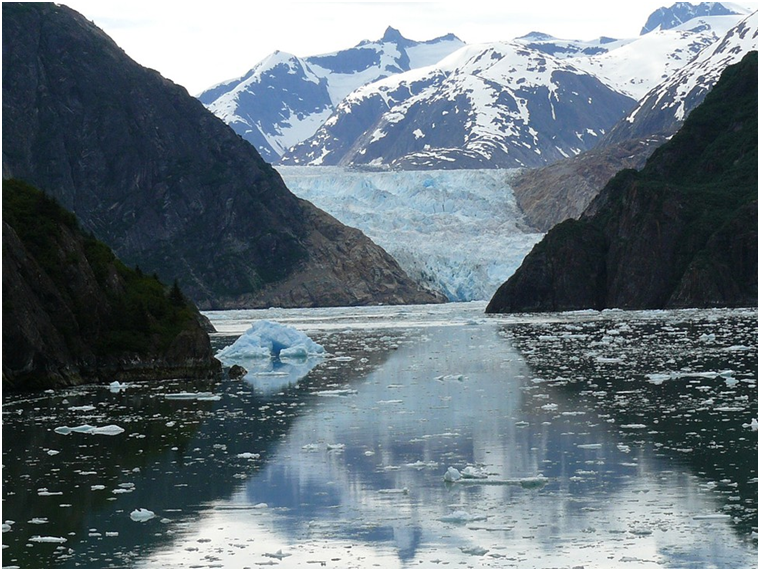
Fjord
Fjord
A diesel fuel spill from a ship that sank recently spreads to the Greenland fjord.

About Fjord:
- A fjord is a long, deep, narrow body of water that reaches far inland.
- Fjords are often set in a U-shaped valleywith steep walls of rock on either side.
- Fjords are found mainly in Norway, Chile, New Zealand, Canada, Greenland, and the U.S. state of Alaska.
How are Fjords Formed?
- Fjords have been shaped throughout the span of several ice ages by slow-moving glaciers.
- As the glacier moved, it cut away at the top layers of ice and into the sediment below.
- Melting waters also carved away into the land, meaning that many fjords are actually deeper than the sea that feeds into it.
- Where the fjord meets the sea, also known as the mouth, many glaciers left behind shill or shoal rock deposits.
- Because the mouth is a shallower opening than the body of the fjord, it results in extremely fast-moving water (this includes strong currents and saltwater rapids).
- Fjords commonly are deeper in their middle and upper reaches than at the seaward end.
- This results from the greater erosive power of the glaciers closer to their source, where they are moving most actively and vigorously.
- Because of the comparatively shallow thresholds of fjords, the bottoms of many have stagnant water and are rich in black mud containing hydrogen sulfide.
- Some features of fjords include coral reefsand rocky islands called skerries.
Epishelf Lakes:
- Another feature of some fjords is the presence of epishelf lakes. These lakes occur when melted fresh water becomes trapped under a floating ice shelf.
- This freshwater does not mix with the saltwater below, but rather floats on top of it.
फजॉर्ड
हाल ही में डूबे एक जहाज से डीजल ईंधन का रिसाव ग्रीनलैंड फ्योर्ड तक फैल गया है।
फजॉर्ड के बारे में:
- फजॉर्ड पानी का एक लंबा, गहरा, संकरा पिंड होता है जो दूर तक अंतर्देशीय क्षेत्र में पहुँचता है।
- फजॉर्ड अक्सर यू-आकार की घाटी में स्थित होते हैं जिसके दोनों ओर चट्टान की खड़ी दीवारें होती हैं।
- फजॉर्ड मुख्य रूप से नॉर्वे, चिली, न्यूजीलैंड, कनाडा, ग्रीनलैंड और यू.एस. राज्य अलास्का में पाए जाते हैं।
फजॉर्ड कैसे बनते हैं?
- कई हिमयुगों के दौरान धीमी गति से चलने वाले ग्लेशियरों द्वारा फजॉर्ड का आकार बनाया गया है।
- जैसे-जैसे ग्लेशियर आगे बढ़ा, उसने बर्फ की ऊपरी परतों को काट दिया और नीचे तलछट में समा गया।
- पिघलते पानी ने भी जमीन को काट दिया, जिसका मतलब है कि कई फजॉर्ड वास्तव में उस समुद्र से भी गहरे हैं जो उसमें मिलता है।
- जहां फजॉर्ड समुद्र से मिलता है, जिसे मुंह के रूप में भी जाना जाता है, कई ग्लेशियर अपने पीछे शिल या शोल रॉक जमा छोड़ गए हैं।
- क्योंकि मुंह फजॉर्ड के शरीर की तुलना में एक उथला उद्घाटन है, इसलिए इसके परिणामस्वरूप बहुत तेज़ गति से बहने वाला पानी होता है (इसमें तेज़ धाराएँ और खारे पानी की तेज़ धाराएँ शामिल हैं)।
- फजॉर्ड आमतौर पर समुद्र की ओर के छोर की तुलना में अपने मध्य और ऊपरी हिस्से में अधिक गहरे होते हैं।
- यह ग्लेशियरों की अधिक क्षरण शक्ति के कारण होता है जो उनके स्रोत के करीब होते हैं, जहाँ वे सबसे अधिक सक्रिय और जोरदार तरीके से आगे बढ़ रहे होते हैं।
- फजॉर्ड की तुलनात्मक रूप से उथली दहलीज के कारण, कई के तल में स्थिर पानी होता है और हाइड्रोजन सल्फाइड युक्त काली मिट्टी से भरपूर होते हैं।
- फजॉर्ड की कुछ विशेषताओं में प्रवाल भित्तियाँ और चट्टानी द्वीप शामिल हैं जिन्हें स्केरीज़ कहा जाता है।
एपिशेल्फ़ झीलें:
- कुछ फजॉर्ड की एक और विशेषता एपिशेल्फ़ झीलों की उपस्थिति है। ये झीलें तब बनती हैं जब पिघला हुआ ताज़ा पानी तैरती हुई बर्फ की शेल्फ के नीचे फंस जाता है।
- यह ताज़ा पानी नीचे के खारे पानी के साथ नहीं मिलता, बल्कि इसके ऊपर तैरता रहता है।